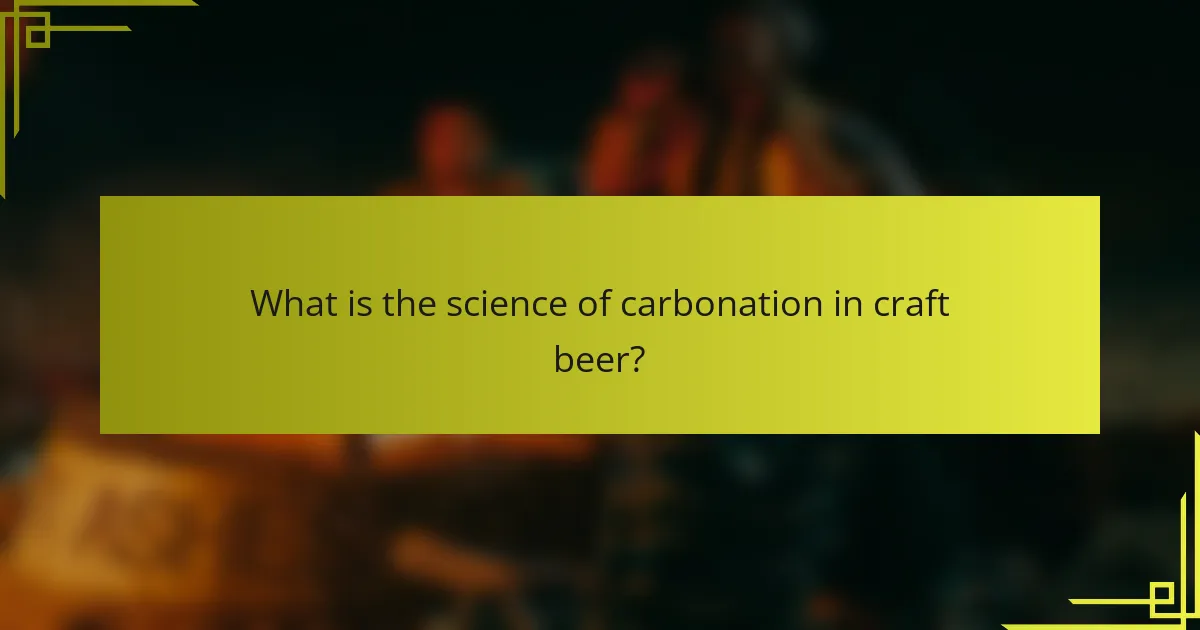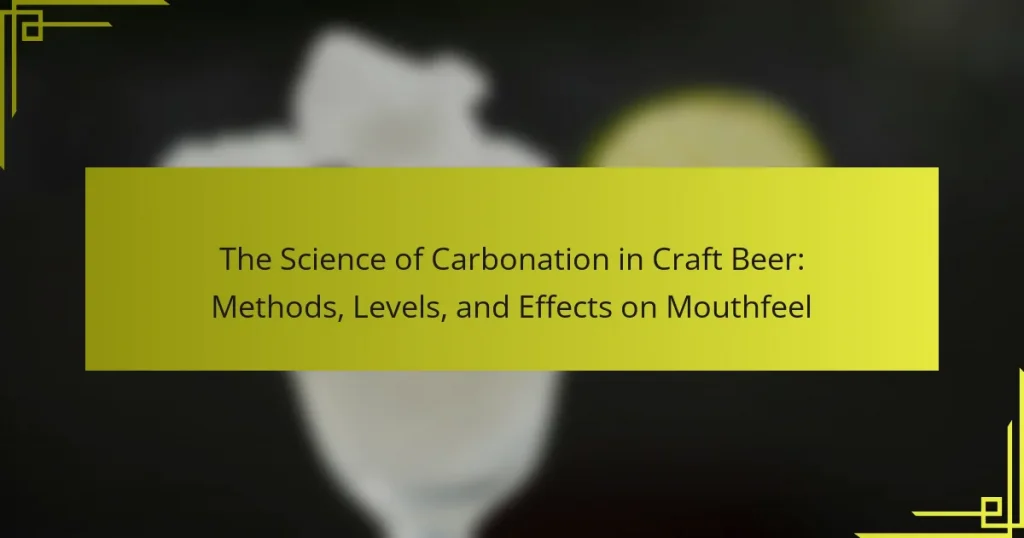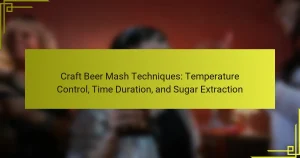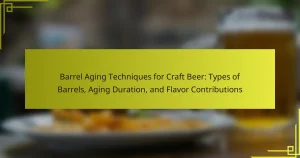Carbonation in craft beer is the presence of dissolved carbon dioxide (CO2), which creates bubbles and enhances the beer’s mouthfeel and sensory experience. This article explores the two primary methods of carbonation: natural carbonation, which occurs during fermentation, and artificial carbonation, where CO2 is injected post-fermentation for precise control. The ideal carbonation level varies by beer style, influencing taste and texture, with higher carbonation leading to a crisper mouthfeel and lower levels resulting in a smoother texture. Additionally, carbonation affects flavor perception, enhancing bitterness and acidity while contributing to aroma release during pouring. Understanding these aspects allows brewers to create beers that meet consumer preferences and align with style guidelines.

What is the science of carbonation in craft beer?
Carbonation in craft beer refers to the presence of dissolved carbon dioxide (CO2) gas. This gas creates bubbles and contributes to the beer’s mouthfeel and overall sensory experience. The science of carbonation involves both natural and artificial methods to achieve desired levels of CO2. Natural carbonation occurs during fermentation when yeast produces CO2 as a byproduct. This method can enhance flavor complexity and is often used in traditional brewing.
Artificial carbonation involves injecting CO2 into the beer after fermentation. This method allows for precise control over carbonation levels. The ideal carbonation level varies by beer style, impacting taste and texture. For example, higher carbonation can lead to a crisper mouthfeel, while lower levels may result in a smoother texture.
Research indicates that carbonation affects flavor perception. Higher carbonation can enhance the perception of bitterness and acidity. Additionally, the release of CO2 during pouring creates aromas that contribute to the overall drinking experience. Understanding the science of carbonation helps brewers create beers that align with consumer preferences and style guidelines.
How does carbonation impact the overall experience of craft beer?
Carbonation significantly enhances the overall experience of craft beer. It affects mouthfeel, aroma, and flavor perception. Higher carbonation levels create a lively, effervescent sensation on the palate. This sensation can accentuate the beer’s freshness and complexity. Carbonation also helps release volatile aroma compounds. These compounds contribute to the beer’s overall fragrance and flavor profile. Studies show that carbonation can influence the perception of bitterness and sweetness. For example, higher carbonation can make a beer taste less sweet. This interaction alters the drinker’s overall enjoyment and satisfaction.
What are the sensory attributes influenced by carbonation?
Carbonation influences several sensory attributes, including texture, aroma, flavor perception, and acidity. The presence of carbon dioxide creates a tingling sensation on the palate, enhancing mouthfeel. This effervescence can also elevate certain aromas, making a beverage more aromatic. Additionally, carbonation can affect flavor perception by enhancing the perception of sweetness and bitterness. A study by the American Chemical Society found that carbonation increases the perception of acidity in beverages. This heightened acidity can make drinks feel more refreshing. Overall, carbonation plays a crucial role in shaping the sensory experience of beverages.
How does carbonation contribute to the perception of flavor?
Carbonation enhances the perception of flavor by stimulating the taste buds and releasing aromatic compounds. The bubbles in carbonated beverages create a tingling sensation on the tongue. This sensation can amplify the overall flavor experience. Additionally, carbonation can influence the aroma of the beverage. The release of volatile compounds occurs as carbonation escapes. Research indicates that carbonation can enhance sweetness perception while masking bitterness. A study published in the Journal of Agricultural and Food Chemistry found that carbonation affects flavor intensity. This effect is particularly noticeable in craft beers, where carbonation levels are carefully controlled.
What methods are used to achieve carbonation in craft beer?
Carbonation in craft beer is achieved primarily through two methods: natural carbonation and forced carbonation. Natural carbonation occurs during fermentation when yeast consumes sugars, producing carbon dioxide (CO2). This method can enhance flavor complexity and is often preferred for traditional styles. Forced carbonation involves adding CO2 directly to the beer using a pressurized system. This method allows for precise control over carbonation levels. Both methods result in the desired effervescence in the final product.
What are the differences between natural and forced carbonation?
Natural carbonation occurs through fermentation, where yeast produces carbon dioxide. This method takes longer and results in a more complex flavor profile. Forced carbonation involves injecting carbon dioxide directly into the beer under pressure. This method is quicker and allows for precise control over carbonation levels. Natural carbonation can lead to a softer mouthfeel, while forced carbonation often results in a sharper sensation. The choice between the two methods can significantly affect the overall taste and experience of the beer.
How does the fermentation process affect carbonation levels?
The fermentation process significantly affects carbonation levels in beverages. During fermentation, yeast converts sugars into alcohol and carbon dioxide (CO2). This CO2 is a natural byproduct of yeast metabolism. As fermentation progresses, the dissolved CO2 creates pressure in the liquid. Higher fermentation temperatures can increase CO2 production, leading to higher carbonation levels. Conversely, lower temperatures may slow yeast activity and reduce carbonation. Additionally, the duration of fermentation influences carbonation; longer fermentation allows more CO2 to be produced and dissolved. Studies show that optimal carbonation levels enhance mouthfeel and overall sensory experience in craft beer.
What are the various levels of carbonation in craft beer?
The various levels of carbonation in craft beer include low, moderate, and high carbonation. Low carbonation typically ranges from 1.5 to 2.2 volumes of CO2. This level provides a smooth mouthfeel and is common in styles like stouts. Moderate carbonation ranges from 2.2 to 2.7 volumes of CO2. This level is often found in pale ales and IPAs, enhancing aroma and flavor. High carbonation exceeds 2.7 volumes of CO2, contributing to a lively and effervescent mouthfeel. Styles such as Belgian ales and wheat beers often exhibit this level. Carbonation levels impact the sensory experience, affecting aroma release and perceived texture.
How are carbonation levels measured in beer?
Carbonation levels in beer are measured using several methods. One common method is the use of a carbonation chart. This chart correlates the temperature of the beer with the desired carbonation level in volumes of CO2. Another method is the use of a pressure gauge on a keg. This gauge measures the pressure exerted by the carbon dioxide in the beer.
A third method involves using a carbonation tester, which can directly measure the amount of dissolved CO2 in the beer. Additionally, sensory evaluation can be employed. This involves tasting the beer to assess the perceived carbonation level.
Research shows that the ideal carbonation level varies by beer style. For example, lagers typically have lower carbonation levels than ales. The Brewers Association suggests that most beers range from 2.2 to 2.8 volumes of CO2.
What factors influence the desired carbonation level for different beer styles?
The desired carbonation level for different beer styles is influenced by factors such as style characteristics, fermentation process, and mouthfeel. Each beer style has a typical carbonation range that enhances its flavor and aroma. For example, Belgian ales often have higher carbonation to accentuate fruity esters. In contrast, stouts may have lower carbonation for a smoother mouthfeel. The fermentation process also affects carbonation; primary fermentation produces CO2, impacting final levels. Additionally, the presence of residual sugars can lead to variations in carbonation. These factors collectively determine the optimal carbonation for a specific beer style.
How does carbonation affect mouthfeel in craft beer?
Carbonation significantly influences the mouthfeel of craft beer. It creates a sensation of effervescence and enhances the perception of body. Higher carbonation levels can lead to a sharper, crisper texture. This crispness often accentuates flavors, making them more pronounced. Conversely, lower carbonation can result in a smoother, creamier mouthfeel. Studies show that carbonation interacts with proteins and other compounds in beer. This interaction can affect the overall perception of sweetness and bitterness. Thus, carbonation is a crucial element in defining the sensory experience of craft beer.
What are the key components of mouthfeel in relation to carbonation?
The key components of mouthfeel in relation to carbonation are texture, effervescence, and acidity. Texture refers to the sensation of the liquid on the palate. It can be influenced by the size and distribution of bubbles. Effervescence describes the perceived intensity of carbonation. Higher carbonation levels can enhance the perception of freshness and liveliness. Acidity contributes to the overall flavor balance and can amplify the mouthfeel experience. Research indicates that carbonation levels directly affect the perception of these components, influencing drinkability and enjoyment.
How does carbonation contribute to the texture and body of beer?
Carbonation significantly influences the texture and body of beer. It creates a sensation of effervescence on the palate. This effervescence can enhance the perception of freshness in the beer. Carbon dioxide bubbles contribute to the mouthfeel by providing a tingling sensation. Higher carbonation levels can lead to a lighter, crisper texture. Conversely, lower carbonation can result in a smoother, creamier body. The carbonation also interacts with the beer’s ingredients, affecting overall flavor perception. Studies show that carbonation can enhance aromas, further enriching the drinking experience.
What are the effects of carbonation on beer aroma and flavor release?
Carbonation significantly influences beer aroma and flavor release. The presence of carbon dioxide enhances the volatility of aromatic compounds. This results in a more pronounced aroma perception. Higher carbonation levels can increase the release of these compounds during consumption. Additionally, carbonation can affect the mouthfeel of the beer. A well-carbonated beer may feel smoother and more refreshing. Studies show that the balance of carbonation is crucial for optimal flavor experience. For example, a study published in the Journal of the American Society of Brewing Chemists found that carbonation levels directly correlate with flavor intensity.
How does carbonation enhance or diminish specific aromas in craft beer?
Carbonation can enhance or diminish specific aromas in craft beer. The presence of carbon dioxide affects the perception of aroma compounds. Higher carbonation levels can intensify volatile aroma molecules. This occurs because carbonation increases the release of these compounds into the air. Conversely, excessive carbonation can mask delicate aromas. It can create a sensory overload, making it difficult to detect subtle notes. Studies show that carbonation interacts with aroma compounds, influencing their volatility. This interaction is crucial for the overall sensory experience of craft beer.
What role does carbonation play in flavor perception during consumption?
Carbonation enhances flavor perception during consumption by providing a unique sensory experience. The bubbles in carbonated beverages stimulate the trigeminal nerve, which contributes to the sensation of freshness and liveliness. This sensory stimulation can amplify the perception of flavors, making them seem more intense. Research indicates that higher carbonation levels can enhance the perception of sweetness and acidity in beverages. Additionally, carbonation can create a more complex flavor profile by releasing volatile compounds that contribute to aroma. These factors combined lead to an overall enhanced tasting experience, particularly in craft beer.
What are some common misconceptions about carbonation in craft beer?
One common misconception about carbonation in craft beer is that higher carbonation always equals better quality. In reality, the ideal carbonation level varies by beer style. For example, a Belgian ale typically has higher carbonation than a stout. Another misconception is that all carbonation comes from added CO2. Many craft beers achieve carbonation naturally through fermentation. Some believe that carbonation only affects mouthfeel. However, it also influences aroma and flavor perception. Lastly, there is a belief that all craft beers are over-carbonated. In fact, many brewers aim for a specific carbonation range to enhance the beer’s characteristics.
Why do some people believe that higher carbonation is always better?
Some people believe that higher carbonation enhances the drinking experience. They associate increased carbonation with a more refreshing and lively mouthfeel. Higher carbonation can amplify aromas, making flavors more pronounced. It also contributes to a creamy texture in certain beers. Additionally, carbonation can help preserve the beer by slowing oxidation. Some consumers perceive that more bubbles indicate a higher quality product. This perception can be influenced by marketing and personal preferences. Ultimately, these factors lead to the belief that higher carbonation is always better.
How can misunderstanding carbonation levels affect brewing practices?
Misunderstanding carbonation levels can significantly impact brewing practices. Incorrect carbonation levels can lead to undesirable mouthfeel and flavor profiles in the final product. Over-carbonation may cause excessive foaming, resulting in loss of beer and a negative drinking experience. Under-carbonation can produce a flat taste, diminishing the beer’s aroma and overall enjoyment.
Brewers often rely on specific measurements of carbonation, typically expressed in volumes of CO2. A standard beer might require 2.2 to 2.7 volumes of CO2 for optimal taste. Deviating from these levels can alter the perceived sweetness and bitterness of the beer.
Additionally, misunderstanding carbonation can affect the fermentation process. Inadequate carbonation might indicate insufficient fermentation, potentially leading to off-flavors. Conversely, over-carbonation can create pressure issues in bottles, risking explosions. Proper understanding and measurement of carbonation levels are essential for achieving consistent quality in craft beer brewing.
What practical tips can brewers use to manage carbonation in craft beer?
Brewers can manage carbonation in craft beer by controlling fermentation temperature and pressure. Maintaining a consistent fermentation temperature helps regulate yeast activity. Yeast activity directly influences carbon dioxide production. Adjusting pressure during fermentation can also impact carbonation levels. Higher pressure can lead to increased carbonation, while lower pressure results in less. Additionally, brewers can use priming sugar to achieve desired carbonation levels during bottling. The amount of sugar added determines the final CO2 concentration. Monitoring specific gravity throughout fermentation provides insight into carbonation readiness. Using a carbonation chart can help brewers calculate the right levels for different beer styles. These tips ensure a balanced mouthfeel and overall quality in the final product.
The main entity of this article is carbonation in craft beer, which refers to the presence of dissolved carbon dioxide (CO2) that impacts mouthfeel, aroma, and flavor perception. The article explores the science behind carbonation, detailing both natural and forced carbonation methods, their effects on sensory attributes, and how carbonation levels vary across different beer styles. It also examines how fermentation influences carbonation, the measurement techniques used, and the misconceptions surrounding carbonation in brewing practices. Additionally, practical tips for brewers to manage carbonation effectively are provided, ensuring optimal quality and consumer satisfaction.




